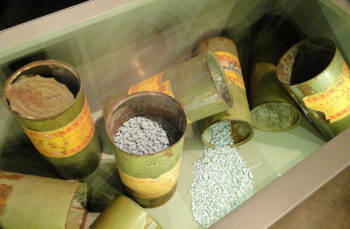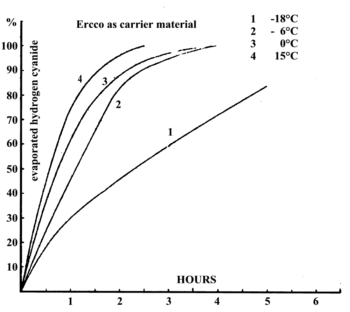Zyklon B
History
One of the most efficient methods to fight lice and thereby to contain and eliminate typhus – and to kill other vermin like grain beetles, fleas, cockroaches, termites, mice, rats and many more as well – is their poisoning with highly volatile hydrogen cyanide.

(Photo by Adam Jones; commons.wikimedia.org)
Liquid hydrogen cyanide has a short shelf life and is extremely dangerous when handled incorrectly. Therefore, the in-situ development of gaseous hydrogen cyanide by pouring a strong acid (usually semi-diluted sulfuric acid) onto a highly soluble cyanide powder (such as sodium or potassium cyanide) was used instead until a few years after the First World War. However, numerous accidents resulted in research efforts to produce a safer method. This resulted in the development of “Zyklon” by German chemists, which was a mixture of a highly irritating liquid with a liquid cyanide component (methyl cyanoformate). Due to the irritant, it was considered safe, hence it was sold so liberally in the early 1920s that accidents occurred again, leading to the ban of all cyanide products for pest control in Germany in July 1922.
In September of 1922, the German Association for Pest Control (Deutsche Gesellschaft für Schädlingsbekämpfung, DEGESCH) was granted the exclusive right to develop and use cyanide-based pest-control chemicals in Germany. Around the same time, DEGESCH developed a superior substitute product for Zyklon, called “Zyklon B,” which was liquid hydrogen cyanide mixed with a chemical stabilizer and a teargas (as a warning agent) absorbed on diatomaceous earth. A little later, this chemical mixture was also sold absorbed on wood-fiber disks, and in the 1930s, diatomaceous earth was replaced by gypsum pellets as the carrier material, which, unlike diatomaceous earth, did not tend to compact during storage and transport, thus keeping its liquid-absorbing properties.
By the advent of Word War Two, almost all Zyklon B sold in Europe consisted of the gypsum type, called “Erco.” This product was packed in tin cans measuring 15.4 cm in diameter and of various heights, depending on the can’s cyanide contents. DEGESCH distributed cans containing 200, 500, 1,000 and 1,500 g of liquid hydrogen cyanide, with the carrier material weighing roughly twice that amount. Hence, a 1-kg-can of Zyklon B contained 1 kg of hydrogen cyanide, plus some 2 kg of gypsum pellets.
While the stabilizer was legally required as an additive to prevent the possibility of violent polymerizations, the warning agent was not required. In fact, it was argued by some that the warning agent was misleading, since it evaporated and dissipated much slower than the almost odorless hydrogen cyanide. Hence, anyone relying on noticing the irritant before assuming that they were at risk would have been in serious danger.
As the war progressed, the producers of Zyklon B had growing difficulties obtaining any irritant, as chemical factories producing it were a main target of Allied bombers, or they suffered war-related shortages. In addition, chemical irritants weren’t high on anyone’s priority lists. As a result, Zyklon B without irritants was the preferred option, in particular for non-civilian customers who did not use the chemical in the potential presence of civilians, such as the Wehrmacht and the SS. The orthodoxy’s occasional claim that this proves homicidal intent is unfounded.
To this day, 100 years after its invention, Zyklon B continues to play a role in the battle against pests.
Evaporation Characteristics

The hydrogen cyanide absorbed by the Zyklon-B gypsum pellets evaporates rather slowly. If the pellets are dispersed (meaning not piled up) and humidity in the air is low, this process lasts roughly two hours at room temperature. This is intentional, since in many civilian applications, the person spreading out the pellets must retreat safely afterwards, and because small leaks in the typical treated building make it desirable that some hydrogen cyanide continues to be released over time, compensating for these losses.
When assessing testimonies reporting homicidal gassings with Zyklon B, two issues are of prime importance: first, the claimed duration of the execution, and second, the claimed duration of the subsequent ventilation.
- Duration of the execution. In contrast to executions in U.S. execution gas chambers, where hydrogen-cyanide vapors are developed instantly in full force and right beneath the victim by pouring semi-diluted sulfuric acid into a bowl of potassium cyanide (see the section on “U.S. Execution Gas Chambers” of the entry on homicidal gas chamber), a hypothetical execution with Zyklon B, thrown into a room full of people, will take much longer, as the gas develops slowly and must dissipate throughout a larger room. While a room tightly filled with (naked) people may reach air temperatures around 30°C, its relative humidity will certainly be close to or right at 100%. While the former helps to speed up the evaporation initially, the latter will lead to humidity condensing on the gypsum pellets, resulting in the evaporation process slowing down to a crawl, since hydrogen cyanide is extremely soluble in water.
Therefore, it must be assumed that any kind of homicide using Zyklon B would be considerably slower than U.S. executions with hydrogen cyanide, which on average lasted some ten minutes, but could take up to almost twenty minutes. Therefore, any reported execution time less than 20 minutes is certainly wrong. In fact, since the goal was to kill every victim – even the toughest one standing in a corner far away from where the Zyklon happens to be – this process almost certainly took even longer than that. Had the Zyklon B not been spread out among the victims but kept piled up in some device with no fan dissipating the vapors, as is claimed for some Zyklon-B introduction devices, the execution process would have been delayed even more due to the piled-up nature of the pellets kept away from the inmates’ movements and body heat. - Ventilation time. No ventilation of a room containing Zyklon B can be successful unless either the Zyklon-B pellets have been removed or all the hydrogen cyanide in them has evaporated. For only two claimed homicidal gas chambers, some witnesses have claimed devices that allowed for the removal of the Zyklon-B pellets from the gas chamber (Crematoria II and III at Auschwitz; see the entry on Zyklon-B introduction devices). In all other cases, the Zyklon B is said to have been sprinkled loosely among the victims. In that case, even the strongest ventilation system would not have succeeded in rendering such a room safe for access until at least an hour, and perhaps two, after the introduction of Zyklon B.
Zyklon Deliveries
Many German concentration camps received copious deliveries of Zyklon B; these were used in disinfestation facilities (rooms or “chambers”) for clothing, linens, and personal items, and in order to disinfest camp facilities, ranging from inmate and guard lodgings to storage and administration facilities. In the camps listed in the following table, Zyklon B is also said to have been misused for mass homicide. In fact, however, there is no solid, non-anecdotal evidence for any of these claims that even a single person was killed with Zyklon B. See the entries for these camps for more details on this.
In general, there was no noticeable difference in the amounts of Zyklon B ordered by camps where mass murder using this product is said to have occurred versus other camps where no such crimes have been reported, such as Buchenwald or Bergen-Belsen. Therefore, the simple fact that any camp received Zyklon B by no means proves that it was misused for murder, as Allied prosecutors wrongly claimed during various post-war trials.
| Camp |
Claimed No. of Victims |
|---|---|
| Auschwitz |
ca. 1,000,000 |
| Dachau |
a handful, if any |
| Gusen |
several hundred |
| Majdanek |
a few thousand, if any |
| Mauthausen |
several thousand |
| Neuengamme |
a few hundred |
| Ravensbrück |
up to 3,000 |
| Sachsenhausen |
several thousand |
| Stutthof |
several thousand |
Auschwitz was by far the camp which received the largest amounts of Zyklon B, but it was also the camp with by far the largest number of inmate lodging buildings and other camp facilities in need of disinfestation. Furthermore, it was the one camp where louse and flee infestation reached cataclysmic dimensions, and thus underwent a massive deployment of all kinds of methods – heat, steam, chemicals (such as DDT) and advanced technologies (such as microwave delousing devices) – to combat these carriers of devastating epidemics. Therefore, the camp’s extraordinary size and the dramatic dimension of its fateful epidemics explain perfectly well the large Zyklon B deliveries to this camp.
(For more details, see Kalthoff/Werner 1998; Leipprand 2008; Rudolf 2020, pp. 70-85, 236-240; Mattogno 2019, pp. 444-453; 2021a, pp. 71-83.)

You need to be a registered user, logged into your account, and your comment must comply with our Acceptable Use Policy, for your comment to get published. (Click here to log in or register.)